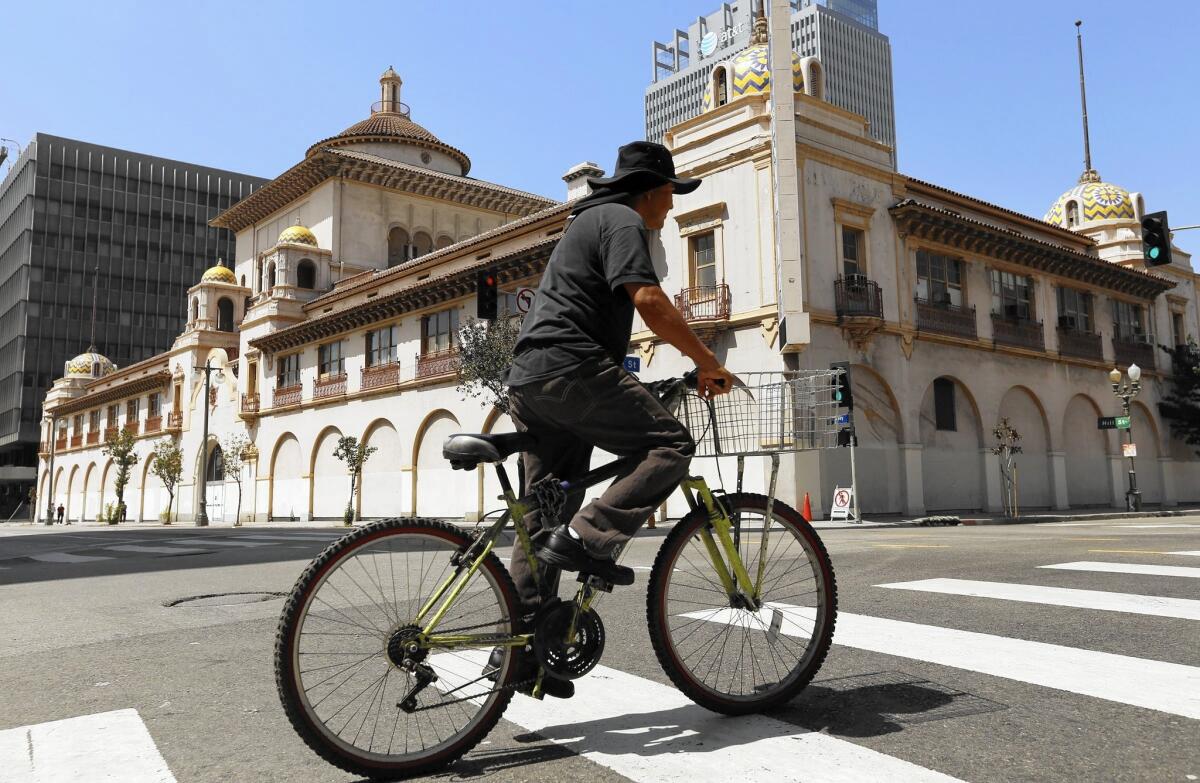Vacant Herald Examiner building in downtown L.A. to be converted to mixed use

The former offices of the Herald Examiner opened a century ago on Broadway with red-tiled roofs and prominent arches in the Mission Revival style inspired by California’s past.
Now the downtown Los Angeles landmark, vacant since the newspaper closed in 1989, will experience yet another sort of revival: conversion into creative offices and mixed use, the latest trend in commercial real estate.
New York developer Georgetown Co. purchased an undisclosed stake in the beige architectural gem from Hearst Corp. and is partnering with the newspaper chain on a $40-million project to redevelop the building into offices and ground-floor restaurants.
Georgetown plans to preserve and restore the ornate lobby and the iconic Spanish-Moorish facade, while opening up the street-level arched windows that were enclosed decades ago during a 10-year strike against the paper.
“It’s been asleep a long time. It’s time to wake her up,” said Steve Hearst, a vice president of Hearst and great grandson of William Randolph Hearst, the newspaper’s founder.
Most of the rest of the building’s interior, which is considered far less architecturally significant, will be converted into about 80,000 square feet of “creative” office space, Georgetown Vice President Michael Fischer said.
Long popular with technology companies, creative offices are now in demand even by law firms and bankers who like the emphasis on open floor plans, shared work spaces and a dash of authenticity such as exposed brick, or in the case of the Herald Examiner, a bit of Spanish architectural flair with ties to a famous press baron.
The development, expected to be completed toward the end of 2017, will join a previously run-down Broadway that’s changed dramatically in recent years. New establishments such as the trendy Ace Hotel two blocks away have helped lure more investment, including boutiques and upscale restaurants.
Across from the Herald building, which is at 11th Street, a historic 13-story tower formerly known as the Case Hotel is being converted into the boutique Downtown L.A. Proper Hotel. And developer Forest City is building two residential and retail complexes, including one directly behind the Herald Examiner, on land that it picked up from Hearst in late 2013.
“Everywhere surrounding us is development activity,” Fischer said.
The old Herald building is iconic for many different reasons, including its architecture and connection to the newspaper magnate, who once kept a private apartment there, said Linda Dishman, president of the Los Angeles Conservancy
“It tells so many stories,” she said, noting that the conservancy supports the repurposing of the building.
In the early 1900s, Hearst commissioned California’s first registered woman architect, Julia Morgan, to design a headquarters for what was then the Los Angeles Examiner prior to a merger with another paper. Morgan, who later designed Hearst Castle, incorporated Spanish, Italian and Moorish touches and created an ornate lobby of marble and gold with hand-painted tiled flooring.
When it opened, the building featured ground-level arched windows. But during a labor rally to support striking Herald Examiner workers in January 1968, many of those were shattered as some in the crowd turned violent and “fireworks began to explode around the premises,” the Los Angeles Times reported.
The windows were soon enclosed with cement to protect the building, Steve Hearst said.
The strike lasted until 1977 and the paper struggled to recover. By the time the feisty and locally focused Herald Examiner closed in 1989, Broadway was no longer a shopping, entertainment and theater hub. Major retailers had decamped for the suburbs and blight had swept up and down the once grand corridor.
The building has remained vacant ever since except for use as a filming site. Last year it was the second-most-filmed location in the Los Angeles area, according to a review of permit data. Over the years, shows such as “It’s Always Sunny in Philadelphia” and “Parenthood” have used the building, where sets such a police station and bar will be torn down to make way for the project.
A previous plan by Hearst to redevelop the building was canceled during the last economic downturn. But with the real estate market on the upswing and a flood of investment pouring into downtown, the company is moving forward with Georgetown as a partner.
Founded in the 1970s by Marshall Rose, Georgetown has developed large-scale properties around the country, including InterActiveCorp’s New York headquarters designed by Frank Gehry and office buildings locally on the Paramount and Sony studio lots. Rose is married to actress Candice Bergen.
Architecture firm Gensler is leading the rehab’s design. Rob Jernigan, the company’s regional managing principal, said most of the newly restored arched windows will open onto the street to allow for outdoor dining.
The public also will have access to the famed lobby, possibly through a restaurant.
“What we are not going to do is put a security guard in the front door to say ‘If you’re not an office space tenant you can’t come into the lobby,’” Jernigan said. “The intent is to have that great lobby be enjoyed and shared by more than just tenants.”
Real estate broker Carle Pierose of Industry Partners, who specializes in leasing creative offices but is not involved with the project, said the development should help pull Broadway’s economic comeback south to 11th Street and perhaps beyond.
But since Morgan and Hearst intended the newspaper to be the sole occupant of the building, it could be a challenge to divide it up into discrete offices.
“It looks like the type of building that would be tricky to multi-tenant,” Pierose said.
Twitter: @khouriandrew
Times staff writer Roger Vincent contributed to this report.







